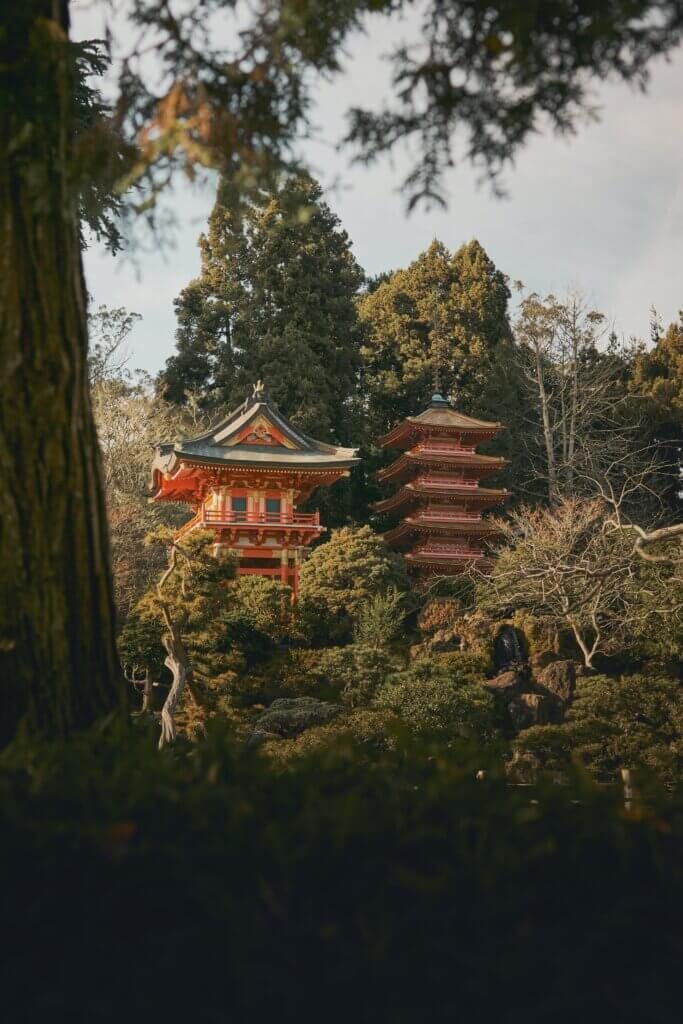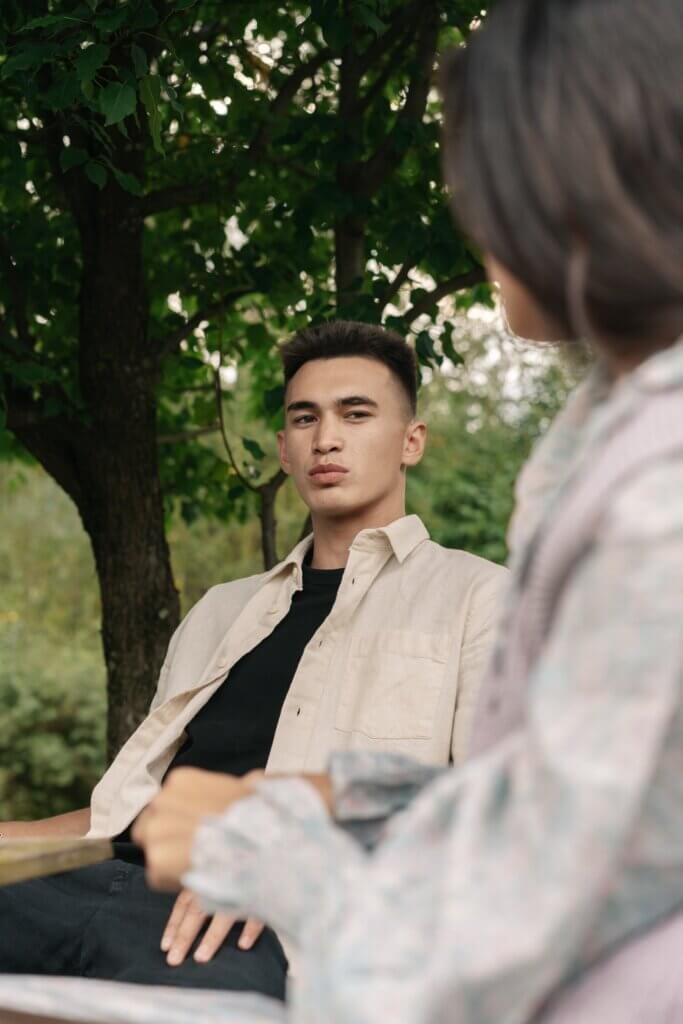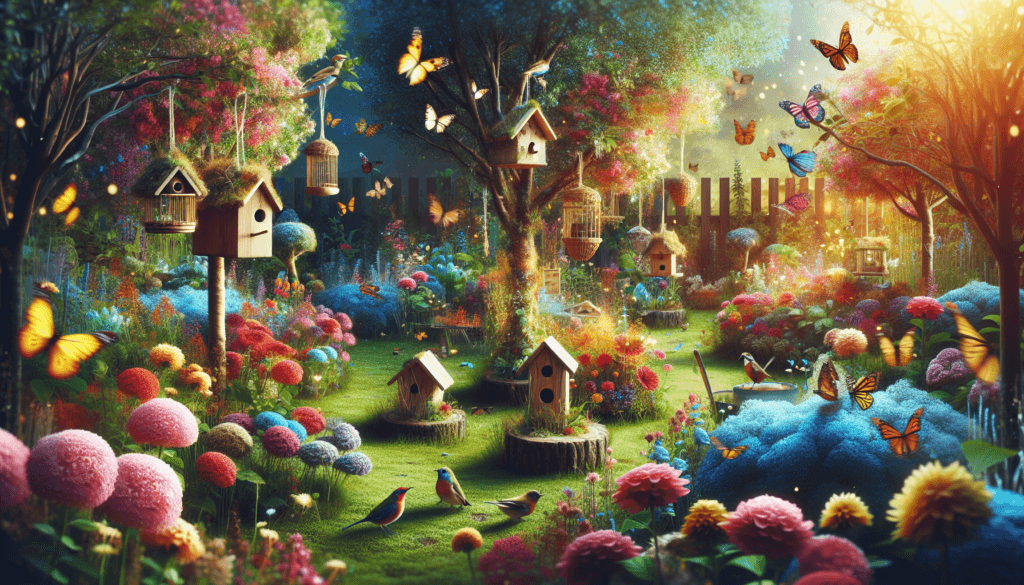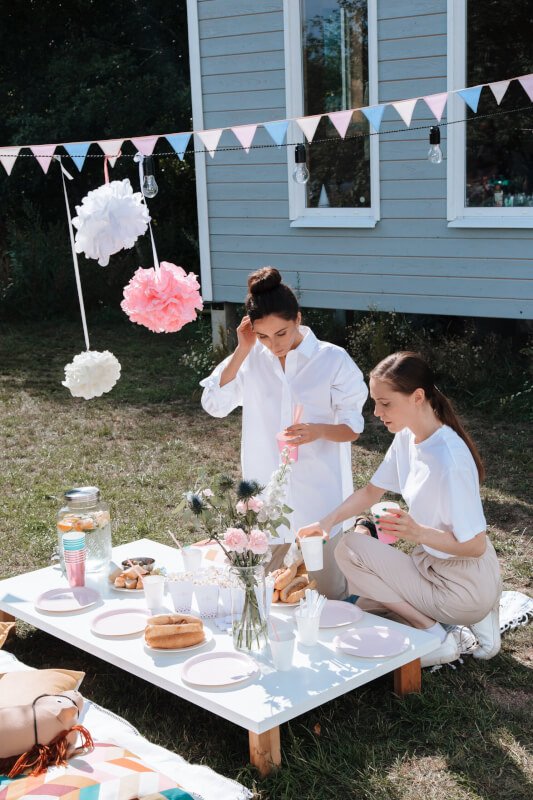Have you ever wondered how to transform your garden into a vibrant oasis for birds and butterflies? Look no further! This article will guide you through a series of delightful and imaginative DIY projects that are guaranteed to attract these beautiful creatures to your outdoor space. From charming bird feeders to whimsical butterfly houses, you’ll discover a host of creative ideas that will not only enhance your garden’s aesthetic but also provide a safe haven for these winged visitors. So grab your tools and get ready to embark on a magical journey of transforming your garden into a haven for birds and butterflies.

Creating a Bird-Friendly Garden
Creating a bird-friendly garden is a wonderful way to welcome these beautiful creatures into your outdoor space. By providing the necessary resources and habitats, you can attract a variety of birds and enjoy their delightful presence. Here are some steps you can take to create a garden that birds will love.
Choose Native Plants
One of the first and most important steps in creating a bird-friendly garden is to choose native plants. Native plants are those that naturally occur in your region and have evolved alongside the local bird species. These plants provide birds with familiar food sources, shelter, and nesting sites. Consider planting a variety of trees, shrubs, and flowers that are native to your area. Not only will these plants attract birds, but they will also support the local ecosystem.
Provide Water Sources
Water is essential for birds, not only for drinking but also for bathing. By providing a water source in your garden, you can attract a wide range of bird species. This can be as simple as a birdbath or a shallow dish of water. Make sure to keep the water fresh and clean, and consider adding rocks or pebbles for birds to perch on. Providing a water source will not only benefit the birds but also add a beautiful focal point to your garden.
Install Birdhouses and Nesting Boxes
Birdhouses and nesting boxes are a great way to attract birds to your garden, especially during the breeding season. Different bird species have different nesting preferences, so consider installing a variety of birdhouses with different sizes and entrance hole diameters. Place them in different locations throughout your garden, ensuring that they are secure and protected from predators. By providing these nesting sites, you can encourage birds to make your garden their home.
Include Food Sources
Another important aspect of creating a bird-friendly garden is to provide food sources for the birds. This can be done by planting specific plants that produce berries or seeds that birds love to eat. For example, sunflowers, blackberries, and coneflowers are all popular choices for attracting birds. You can also consider installing bird feeders with seeds, suet, or nectar. Make sure to regularly clean and refill the feeders to keep the food fresh and prevent the spread of disease.
Creating a Butterfly-Friendly Garden
Butterflies are enchanting creatures that add a touch of magic to any garden. Creating a butterfly-friendly garden not only attracts these beautiful insects but also supports their life cycle. By providing the right resources and habitats, you can help butterflies thrive in your garden. Here are some steps you can take to create a garden that butterflies will love.
Choose Host Plants
Host plants are plants that caterpillars feed on. By including host plants in your garden, you provide a crucial food source for butterfly larvae. Research the specific butterfly species that are native to your area and find out which plants they rely on for their survival. Planting a variety of host plants will attract different butterfly species and ensure a diverse butterfly population in your garden.
Provide Nectar Plants
Adult butterflies rely on nectar as their primary food source. By including nectar plants in your garden, you provide a valuable food source for butterflies. Choose flowering plants that have a high nectar content and are native to your region. Popular choices include lavender, butterfly bush, and milkweed. Make sure to provide a continuous bloom of nectar plants throughout the seasons to attract butterflies year-round.
Create Sheltered Areas
Butterflies need sheltered areas where they can rest and hide from predators. This can be achieved by planting dense shrubs or installing trellises with climbing plants. By creating sheltered areas, you provide butterflies with a safe haven in your garden. Consider incorporating a variety of heights and textures to attract different butterfly species.
Add Water Sources
Just like birds, butterflies also need water. By providing a water source in your garden, you can attract butterflies and offer them a place to drink. Shallow dishes with pebbles or rocks work well as butterfly watering stations. Make sure to keep the water fresh and replace it regularly to prevent mosquito breeding.
DIY Bird Feeders
Feeding birds can be a fun and rewarding activity. By creating your own bird feeders, you can customize them to suit the needs of specific bird species and add a personal touch to your garden. Here are a few DIY bird feeder ideas to get you started.
Pinecone Bird Feeder
A pinecone bird feeder is a simple and natural way to attract birds to your garden. Begin by tying a piece of string or twine around the top of a pinecone. Then, spread a layer of peanut butter or birdseed mixture onto the pinecone, making sure to cover it completely. Hang the pinecone in a tree or from a hook, and watch as the birds flock to enjoy the tasty treat.
Citrus Peel Bird Feeder
A citrus peel bird feeder is a creative way to reuse leftover fruit peels and attract birds to your garden. Start by cutting an orange, grapefruit, or lemon in half and scooping out the fruit. Thread a piece of string or twine through the peel, creating a loop at the top for hanging. Fill the peel with a mixture of birdseed and suet, and hang it in your garden. The bright colors and enticing aroma will surely attract birds.
Milk Carton Bird Feeder
A milk carton bird feeder is an eco-friendly option that repurposes a common household item. Start by cleaning and drying an empty milk carton. Cut a large hole on one side of the carton, leaving enough space at the bottom for birds to perch. Make smaller holes on each side, near the top, and thread a string or wire through them for hanging. Fill the carton with birdseed and hang it in your garden. The birds will appreciate the convenient feeding station.
DIY Butterfly Feeders
Butterflies are not only beautiful to look at but also important pollinators. By creating your own butterfly feeders, you can provide them with a reliable source of food and support their vital role in the ecosystem. Here are a couple of DIY butterfly feeder ideas to attract these delicate creatures to your garden.
Fruit Feeder
Butterflies are attracted to the sweet juices of rotting fruits. To create a fruit feeder, simply place overripe fruits, such as bananas or melons, in a shallow dish or tray. Add a few rocks or pebbles for the butterflies to perch on while feasting on the fruit. Place the fruit feeder in a sunny spot in your garden, and watch as the butterflies gather.
Butterfly Puddler
A butterfly puddler is a shallow dish filled with water and minerals that butterflies use to extract nutrients. Start by choosing a shallow dish or tray with a smooth bottom. Fill it with sand or soil, and then add enough water to moisten it, creating a muddy consistency. Place the butterfly puddler in a sunny area, and make sure to keep it filled with fresh water. Butterflies will come to drink from the puddler and absorb the essential minerals.

DIY Bird Baths
Bird baths are not only a beautiful addition to your garden but also a valuable water source for birds. By creating your own bird baths, you can provide birds with a safe and clean place to drink, bathe, and cool off. Here are a few DIY bird bath ideas to enhance your garden.
Terracotta Pot Bird Bath
A terracotta pot bird bath is a simple and elegant DIY project. Start by selecting a large terracotta pot and a dish or saucer that fits securely on top. Turn the pot upside down, and place the saucer on the bottom of the pot. Secure it with waterproof adhesive if necessary. Fill the saucer with water, and place the bird bath in your garden. The birds will appreciate the inviting water source.
Upcycled Basin Bird Bath
Transforming an old basin or bowl into a bird bath is a creative way to repurpose materials and attract birds to your garden. Start by selecting a basin or bowl that is deep enough for birds to bathe in but not too deep to pose a drowning risk. Place the basin on a sturdy base, such as a stand or pedestal. Fill it with water, and position it in a quiet and safe spot in your garden. The birds will love the accessible bathing area.
Saucer Bird Bath
A saucer bird bath is a simple and budget-friendly option that can easily be created with household items. Start by selecting a shallow dish or saucer, such as a large plant saucer or a dinner plate. Place it on a flat surface, such as a tree stump or a brick. Fill the saucer with water, making sure to keep it shallow to prevent birds from drowning. Position the saucer bird bath in your garden, and enjoy watching the birds splash and play.
DIY Butterfly Puddles
Creating butterfly puddles in your garden is a great way to provide butterflies with the water and minerals they need for their survival. By following these DIY ideas, you can create inviting puddles that butterflies will be drawn to.
Shallow Dish Puddle
A shallow dish puddle is a simple and effective way to attract butterflies to your garden. Start by selecting a shallow dish or tray with a smooth and flat bottom. Place it in a sunny spot in your garden, preferably near nectar plants. Fill the dish with a small layer of sand or soil, and then add water to moisten it. Make sure to keep the puddle filled with water to entice butterflies to visit and gather nutrients.
Sand and Mud Puddle
Sand and mud puddles mimic natural puddles that butterflies use to obtain minerals. To create a sand and mud puddle, dig a shallow hole in the ground and line it with a plastic or metal tray. Fill the tray with a mixture of sand, soil, and water, creating a thick mud consistency. Place the tray in a sunny area and keep it moist. Butterflies will be attracted to the mineral-rich mixture and use it for nourishment and hydration.

DIY Birdhouses
Birdhouses are an essential addition to any bird-friendly garden. By creating your own birdhouses, you can provide birds with safe and secure nesting sites. Here are a few DIY birdhouse ideas to inspire you.
Simple Wooden Birdhouse
A simple wooden birdhouse is a classic design that birds will appreciate. Start by cutting a piece of untreated wood into the desired shape and size for your birdhouse. Make a small hole near the top for the entrance and several ventilation holes near the top and bottom. Attach a sturdy base and a hinged roof for easy cleaning and monitoring. Mount the birdhouse on a post, tree, or fence, and enjoy watching birds make it their home.
Gourd Birdhouse
Using a gourd as a birdhouse not only provides a unique and natural look but also offers birds a cozy nesting spot. Start by selecting a dried gourd that is clean and free from mold or rot. Make a small hole near the top for the entrance and several drainage holes near the bottom to prevent water buildup. Drill ventilation holes near the top and attach a sturdy base with a hinged roof. Hang the gourd birdhouse in your garden, and watch as birds seek refuge in their new home.
Upcycled Materials Birdhouse
Creating a birdhouse from upcycled materials not only benefits the environment but also adds a touch of creativity to your garden. Start by repurposing materials such as old wooden crates, tin cans, or teapots. Cut or shape the chosen material to create an entrance hole and attach a sturdy base and a roof. Make sure the birdhouse is weatherproof and secure enough for birds to nest in safely. Hang or mount the upcycled birdhouse in your garden, and let your imagination soar.
DIY Butterfly Houses
Butterfly houses provide shelter and roosting spots for butterflies, especially during unfavorable weather conditions. By creating your own butterfly houses, you can offer these delicate creatures a safe haven in your garden. Here are a couple of DIY butterfly house ideas to inspire you.
Stacked Branch Butterfly House
A stacked branch butterfly house is a natural and rustic addition to your garden. Start by collecting several branches of various lengths and thicknesses. Bundle the branches together, ensuring that they are tightly bound and securely tied. Place the bundle in a corner of your garden or attach it to a wall or fence. Butterflies will appreciate the sheltered spaces between the branches for roosting during wind, rain, or cold weather.
Bamboo Butterfly House
Creating a bamboo butterfly house not only provides a functional shelter but also adds an Asian-inspired touch to your garden. Start by cutting a piece of bamboo tube, approximately six inches in length, with one closed end. Attach several pieces of bamboo together to create a structure with multiple chambers. Hang the bamboo butterfly house in a protected area of your garden, ensuring that it is secure and stable. Butterflies will enjoy the cozy retreat during unfavorable weather conditions.

DIY Butterfly Gardens
Creating a butterfly garden is a wonderful way to attract and support butterflies throughout their life cycle. By planting the right flowers and creating the ideal environment, you can provide butterflies with food, shelter, and breeding opportunities. Here are a few DIY ideas to help you create a stunning butterfly garden.
Container Butterfly Garden
A container butterfly garden is a perfect option for small spaces or for adding a splash of color to your patio or balcony. Start by selecting a variety of flowering plants that attract butterflies, such as milkweed, aster, or butterfly bush. Choose containers with drainage holes and fill them with potting soil. Arrange the plants in the containers, ensuring that they receive sufficient sunlight and water regularly. Place the containers in a location that allows butterflies easy access and watch as they flutter around your garden in delight.
Butterfly Garden Border
Creating a butterfly garden border is a great way to incorporate butterflies into your existing garden or landscape. Begin by selecting a sunny spot in your garden with well-draining soil. Choose a variety of flowering plants that provide nectar, such as zinnias, coneflowers, and phlox. Plant the flowers in a curved border shape, ensuring that they form a continuous bloom throughout the season. Add a few host plants, such as milkweed, to support the butterfly larvae. Sit back and watch as your garden comes to life with the vibrant colors and graceful movements of butterflies.
DIY Bird and Butterfly Photography Stations
Creating photography stations in your garden allows you to observe and capture the beauty of birds and butterflies up close. By providing perches, water sources, and food stands, you can create a natural and inviting setting for photography. Here are a few DIY ideas to help you set up bird and butterfly photography stations.
Photography Perches
Photography perches provide birds with a convenient spot to rest and pose for pictures. Start by selecting sturdy branches or dowels of varying thicknesses and lengths. Attach the perches to a stable base, such as a wooden platform or a metal pole. Place the perches in a strategic location near bird feeders, birdbaths, or birdhouses. Set up your camera and wait for the perfect shot of birds perched on your photography stations.
Water and Fruit Stands
Water and fruit stands attract birds and butterflies, allowing you to capture unique images of these creatures in action. Start by placing a shallow dish filled with water near your photography station. Add rocks or pebbles for birds to perch on. Place ripe fruits, such as berries or slices of melon, on another tray or branch nearby. Drape a colorful cloth or backdrop behind the stands for an artistic touch. Set up your camera and be prepared to snap stunning photos of birds and butterflies enjoying the refreshments.
In conclusion, creating a bird-friendly and butterfly-friendly garden is a delightful and rewarding endeavor. By choosing native plants, providing water sources, installing birdhouses and nesting boxes, and including food sources, you can attract a diverse range of bird species and support their well-being. Likewise, choosing host plants, providing nectar plants, creating sheltered areas, and adding water sources will attract and support butterflies throughout their life cycle. By incorporating DIY projects such as bird feeders, butterfly feeders, bird baths, butterfly puddles, birdhouses, butterfly houses, butterfly gardens, and photography stations, you can enhance the attractiveness and functionality of your garden. So, roll up your sleeves, get creative, and enjoy the beauty and wonder of birds and butterflies in your own backyard.



